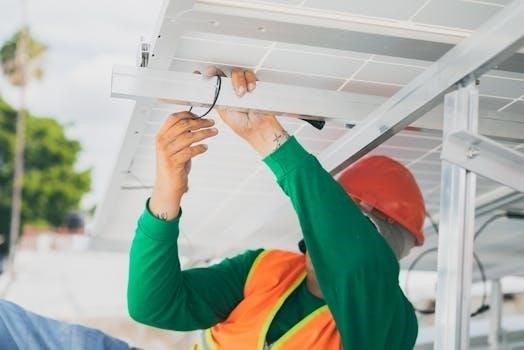MPPT Solar Charge Controller Manual⁚ A Comprehensive Guide
This comprehensive guide provides essential information for understanding and utilizing MPPT solar charge controllers. It covers safety‚ installation‚ operation‚ and troubleshooting‚ ensuring optimal solar energy harvesting and efficient battery charging. Maximize your solar system’s performance with this manual.
MPPT (Maximum Power Point Tracking) solar charge controllers are vital components in modern solar power systems. Unlike traditional PWM controllers‚ MPPT controllers optimize the energy transfer from solar panels to batteries. They employ advanced algorithms to continuously track the maximum power point of the solar array‚ ensuring the highest possible energy yield under varying conditions. This technology maximizes energy utilization‚ improving system efficiency. MPPT controllers adapt to changing sunlight levels and temperature‚ dynamically adjusting the voltage and current to match the battery’s charging requirements. They are particularly beneficial in systems with fluctuating solar irradiance‚ where traditional controllers may struggle to maintain optimal charging. By efficiently converting excess voltage into current‚ MPPT controllers minimize energy waste and ensure faster‚ more complete battery charging. They also often include built-in protection features such as overcharge‚ over-discharge‚ and reverse polarity protection‚ enhancing system safety and reliability. Choosing an MPPT controller can significantly improve the performance and lifespan of your solar power system.
Understanding MPPT Technology
MPPT‚ or Maximum Power Point Tracking‚ is a crucial technology in solar charge controllers that optimizes the power transfer from solar panels to batteries. Solar panels have a specific voltage and current combination at which they produce maximum power‚ known as the maximum power point (MPP). This point varies depending on sunlight intensity‚ temperature‚ and panel characteristics. MPPT controllers use sophisticated algorithms to continuously track and adjust to this MPP‚ ensuring that the batteries receive the highest possible charging power. Unlike PWM controllers‚ which simply connect the solar panel directly to the battery‚ MPPT controllers act as a smart DC-to-DC converter. They efficiently convert the excess voltage from the solar panel into additional current for charging the battery. This process significantly improves the overall efficiency of the solar power system‚ especially in situations where the solar panel voltage is much higher than the battery voltage. By constantly seeking the MPP‚ MPPT controllers maximize energy harvest‚ reduce energy waste‚ and shorten battery charging times. This advanced technology makes MPPT controllers an essential component for efficient and reliable solar power systems.

Safety Precautions and General Guidelines

Before installing or operating an MPPT solar charge controller‚ it is crucial to prioritize safety and adhere to general guidelines. Always disconnect the solar panels and battery before performing any wiring or maintenance. Ensure the controller is mounted indoors in a well-ventilated area‚ away from moisture and direct sunlight. Verify that all wiring connections are secure and properly sized to handle the current. Use appropriate fuses or circuit breakers to protect the system from overcurrents and short circuits. Consult the controller’s manual for specific voltage and current ratings and never exceed them. When working with batteries‚ wear appropriate personal protective equipment‚ such as gloves and eye protection‚ to avoid acid burns or explosions. Avoid working on the system during thunderstorms or in wet conditions. Regularly inspect the wiring and connections for any signs of damage or corrosion. If any issues are detected‚ address them immediately. Following these safety precautions and general guidelines will ensure safe and reliable operation of the MPPT solar charge controller‚ protecting both the equipment and the user.
Installation Procedures
Proper installation is crucial for the optimal performance and longevity of your MPPT solar charge controller. Begin by selecting a suitable mounting location indoors‚ protected from the elements. Ensure adequate ventilation around the controller to prevent overheating. Mount the controller securely to a wall or other stable surface‚ following the manufacturer’s instructions. Next‚ connect the battery to the controller‚ ensuring correct polarity. Then‚ connect the solar panels to the controller‚ again verifying polarity. Use appropriately sized wiring for all connections‚ and secure them tightly. If using multiple solar panels‚ wire them in series or parallel according to the system’s voltage and current requirements. After wiring the controller and panels‚ check all connections for tightness and proper polarity. Finally‚ power on the controller and verify that it is operating correctly. Monitor the charging process and check for any error codes. If any issues arise‚ consult the troubleshooting section of the manual. Regular inspection of the installation and connections is also recommended to avoid any potential problems‚ ensuring the system is reliable.
Operating Instructions
Operating your MPPT solar charge controller effectively involves understanding its features and settings. Begin by familiarizing yourself with the controller’s display and interface‚ which typically show voltage‚ current‚ and charging status. Most controllers have adjustable parameters‚ such as battery type and charging profiles. Select the correct battery type (e.g.‚ lead-acid‚ lithium) to ensure proper charging. Configure the charging profile according to the battery manufacturer’s recommendations. Monitor the charging process regularly to ensure it is proceeding as expected. Observe the voltage and current readings to identify any potential issues. Many MPPT controllers offer advanced features‚ such as data logging and remote monitoring via Bluetooth or Wi-Fi. Utilize these features to track performance and optimize charging. Some controllers also have load output‚ which allows you to control connected devices based on battery charge. Consult the manual for detailed instructions on using these features. Regularly check the controller’s settings and adjust as needed to maintain optimal performance and prolong battery life. Additionally‚ ensure that the solar panels are clean and free from obstructions to maximize energy harvesting.
MPPT Charging Process
The MPPT charging process is a sophisticated method for maximizing energy transfer from solar panels to batteries. It begins with the controller continuously tracking the maximum power point (MPP) of the solar array‚ irrespective of changing sunlight conditions or temperature. The controller uses an advanced algorithm to find the voltage and current combination that yields the highest power output from the panels. Once the MPP is identified‚ the controller adjusts its internal circuitry to efficiently convert the solar panel’s voltage to the appropriate charging voltage for the battery. This conversion process often involves stepping down the voltage and increasing the current‚ optimizing the charging rate. The charging process typically involves multiple stages‚ such as bulk‚ absorption‚ and float‚ to ensure the battery is fully charged without overcharging. During the bulk stage‚ the battery receives the maximum current the controller can deliver. In the absorption stage‚ the voltage is held constant while the current gradually decreases. Finally‚ the float stage maintains a lower voltage to compensate for self-discharge. This multi-stage charging ensures optimal battery health and longevity. Regular monitoring of the charging process is crucial to identify any deviations from the expected behavior and ensure efficient energy transfer.
Troubleshooting Common Issues
MPPT solar charge controllers‚ while generally reliable‚ can occasionally encounter issues that require troubleshooting. One common problem is low or no power output‚ which could stem from several causes‚ including faulty wiring‚ shading on the solar panels‚ or a malfunctioning controller. Begin by inspecting all wiring connections for looseness or corrosion. Ensure that the solar panels are clean and free from obstructions that could reduce their output. Check the controller’s display for error codes‚ which can provide valuable clues about the nature of the problem. If the controller indicates a PV over-voltage error‚ verify that the solar panel array’s voltage is within the controller’s specified limits. Another frequent issue is incorrect battery charging‚ which can lead to overcharging or undercharging. Verify the battery type setting on the controller to ensure it matches the battery chemistry. Also‚ check the battery voltage to confirm it is within the expected range. Overheating can also cause problems. Ensure the controller has adequate ventilation and is not installed in direct sunlight. If the controller is consistently overheating‚ consider relocating it to a cooler environment. Regularly consulting the manufacturer’s manual for specific troubleshooting steps is essential for resolving more complex issues. When in doubt‚ consult a qualified solar technician.
Maintenance and Care

Proper maintenance and care are essential for ensuring the long-term performance and reliability of your MPPT solar charge controller. Regular inspections should be conducted to identify any potential issues before they escalate. Visually inspect the controller for signs of physical damage‚ such as cracks‚ corrosion‚ or loose connections. Check all wiring connections to ensure they are secure and free from corrosion. Clean the controller’s exterior with a soft‚ dry cloth to remove dust and debris‚ which can impede airflow and lead to overheating. Periodically check the controller’s display for error codes or unusual readings‚ which may indicate underlying problems. Ensure that the controller’s cooling fan‚ if equipped‚ is functioning correctly and free from obstructions. Inspect the surrounding area for any potential hazards‚ such as moisture or pests‚ that could damage the controller. Consider using a surge protector to protect the controller from voltage spikes caused by lightning or grid fluctuations. If the controller is located in a harsh environment‚ such as a coastal area‚ take extra precautions to protect it from corrosion. Regularly reviewing the manufacturer’s recommendations for maintenance and care is crucial for maximizing the lifespan of your MPPT solar charge controller. With consistent attention‚ your controller will continue functioning correctly for years.

Advanced Features and Communication
Modern MPPT solar charge controllers often incorporate advanced features and communication capabilities that enhance system monitoring‚ control‚ and optimization. Many controllers offer remote monitoring via Bluetooth or Wi-Fi‚ allowing users to track system performance from smartphones or computers. Data logging features enable the recording of historical data‚ such as voltage‚ current‚ and power‚ for analysis and troubleshooting. Some controllers support communication protocols like Modbus‚ allowing integration with home automation systems or industrial control networks. Advanced algorithms‚ like dynamic MPPT tracking‚ optimize energy harvesting in varying conditions. Load output control allows for managing DC loads based on battery voltage or time schedules. Battery equalization features help maintain battery health by balancing cell voltages. Temperature compensation adjusts charging parameters based on battery temperature‚ preventing overcharging or undercharging. Some controllers offer multi-stage charging profiles tailored to different battery types‚ such as lithium-ion or lead-acid. Built-in protection features‚ such as over-voltage‚ over-current‚ and short-circuit protection‚ ensure system safety. Display interfaces provide real-time information about system status and performance. These advanced features empower users to fine-tune their solar energy systems for maximum efficiency and longevity. Understanding these features allows for informed decision-making and optimal utilization of the MPPT controller’s capabilities.
